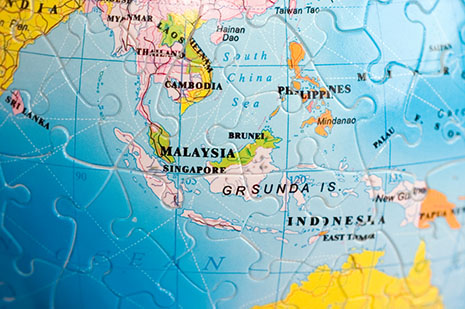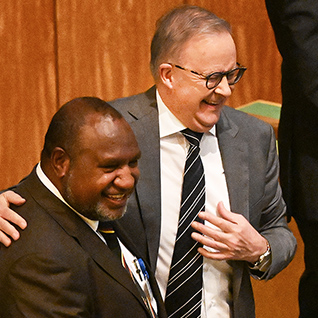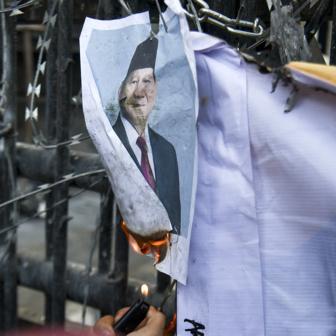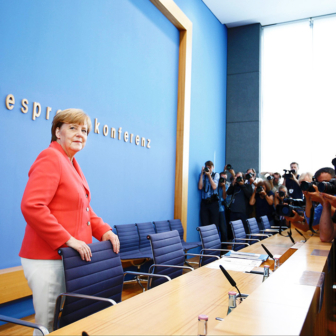BETWEEN 1 July 2008 and 30 June 2009, 5304 individuals sought refuge in Australia by applying for a protection visa onshore. Some of them – 966 to be precise – happen to have arrived by boat without prior authorisation. The federal opposition argued that that the policies of the Rudd government had encouraged a new wave of people smuggling through Indonesia to Australia. Although there may be a small element of truth to this, the government is correct to insist that the recent upsurge in arrivals is part of a worldwide phenomenon largely explained by events in source and transit countries. The four largest refugee populations in the Asia-Pacific region are Afghans, Burmese, Iraqis and Sri Lankans, and it isn’t surprising that some of them have come our way using any means available.
Afghanistan’s turbulent history since the 1979 Soviet invasion has made it the world’s largest producer of refugees. Although the American military action against al Qaeda led to the downfall of the Taliban – a regime whose grave and widespread human rights abuses created a flow of refugees – the ongoing conflict in Afghanistan since 2001 is itself causing forced displacement. By the end of 2008, 2,856,307 Afghan refugees and asylum seekers were living outside their home country, with the vast majority in Iran and Pakistan. In 2009, the deteriorating security situation in Afghanistan caused thousands more to flee. Meanwhile, Afghans who had found refuge in Iran and Pakistan came under increasing pressure from the governments of those countries to move on. As a consequence, they have been fleeing further afield. In the period from January to September 2009, 16,743 Afghans lodged new asylum claims in European countries, far more than in the same period a year earlier. Countries in the Asia-Pacific region, including Australia, have also experienced a surge in Afghan asylum seekers.
Burma is run by a military junta that ruthlessly suppresses political opposition. It is known to hold at least 2000 long-term political prisoners and to engage in extrajudicial killings, torture and other serious human rights violations in response to popular uprisings and incursions by ethnic rebel groups. In consequence, some 206,750 Burmese refugees and asylum seekers were living mostly in Bangladesh, Malaysia and Thailand at the end of 2008. In 2009, intensified civil conflict in Burma caused thousands more to flee, mainly into other countries in the Asia-Pacific region.
As at the end of 2002, 421,700 Iraqis had been forced out of their home country by the atrocities of Saddam Hussein’s regime. Despite the US-led military action, Iraq remains insecure and forced displacement has continued. At the end of 2008, 1,903,519 Iraqis were refugees, most of them in Syria and Jordan. In each of the last four year, enough Iraqis have also made their way to the west to make Iraq the number one source country for asylum seekers seeking protection in the industrialised world. But the number of Iraqi asylum seekers arriving in industrialised countries has been on the decline in 2009, a trend which has also manifested itself in Australia.
For most of the past twenty-five years Sri Lanka was embroiled in civil war, in the course of which both the Sri Lankan government and the separatist rebel group, the Liberation Tigers of Tamil Eelam, committed serious and widespread human rights abuses. At the end of 2008, 144,809 Sri Lankan refugees and asylum seekers were living abroad, about half of them in India. The other main countries of asylum for Sri Lankans were Canada, France, Germany and Britain. The final phase of the Sri Lankan civil war was particularly brutal and resulted in mass displacement; by mid-November 2009, 143,161 of the approximately 274,000 civilians who had been internally displaced were still in government-run camps awaiting resettlement. The Sri Lankan government has indicated that most of the remaining internally displaced people will be resettled by 31 December 2009, while arguing that the pace of resettlement will depend to some extent on the pace at which de-mining of the North can be accomplished. Conditions in the camps are appalling and the fate of those singled out as supporters of the Tigers is uncertain. What is certain is that Sri Lankans are continuing to flee the country in search of asylum.
Over 90 per cent of the mostly Middle Eastern and Sri Lankan asylum seekers who have travelled irregularly to Australia by boat have been determined to be refugees entitled to benefit from Australia’s international protection obligations. The problem from the perspective of successive Australian governments is that the need to give effect to these obligations is at odds with the desire to “decide who comes to this country and the circumstances in which they come.” Accordingly, Australia has long had a system of offshore border controls designed to minimise the number of asylum seekers who come its way.
HOW DOES this system work? For a start, all non-citizens travelling to Australia must obtain a visa in advance. People seen as potential asylum seekers are unlikely to be granted visas. International carriers are penalised if they bring people into Australia whose documentation is not adequate, which is a very effective incentive for carriers to scrutinise their passengers carefully and deny passage to those who might be rejected by Australian authorities. For many years Australia has also posted its own immigration, customs, police and other officials in potential source and transit countries to assist in interception, and has poured millions of dollars into building the border control capacity of countries in its region.
Australia’s cooperation with Indonesia is particularly intense. Among other things, it has led to eighty-nine interceptions involving 2221 people over the past twelve months. For reasons I canvassed in an earlier article for Inside Story, although asylum seekers intercepted in Indonesia are worse off than they would have been if they had made it to Australia, they are at least a lot better off than if they had been intercepted in some other countries in the region – for example, in Malaysia.
Malaysia is host to about 90,000 refugees and asylum seekers. While it is impossible to estimate what proportion of the individuals in Malaysia plan to travel on to Australia, it is a fact that many of the asylum seekers who arrive without authorisation in Australian waters have followed a route which has taken them through Malaysia and Indonesia. A few have also travelled through Malaysia directly to Australia.
It is not difficult to understand why asylum seekers would wish to move on from Malaysia. Without proper authorisation, new arrivals face fines, jail, caning and eventual deportation, even if they have sought asylum. While Malaysia permits the UNHCR to conduct refugee status determinations within its territory and sometimes complies with UNHCR requests, it does not consider itself in any way bound to do so. As a result, there have been many documented cases in which it has engaged in refoulement, sending asylum seekers back into danger. Human rights organisations have documented many other serious human rights violations at the hands of the People’s Volunteer Corps and corrupt Malaysian officials. Notwithstanding all of this, Australia is acting to ensure that asylum seekers in Malaysia are prevented from travelling onward to Australia.
The Australian Department of Immigration has officers in Malaysia, including an Air Line Liaison Officer, or ALO, stationed at the international airport in Kuala Lumpur. The main function of Australian ALOs, who are specialist document examiners, is to assist local immigration and airport authorities and airline personnel to check for false passports and visas. On 1 January 2005, for example, eleven Afghans attempting to travel from the Middle East to Brisbane on counterfeit Australian visas were intercepted at the Kuala Lumpur airport by an Australian ALO. They were detained by Malaysian immigration authorities and returned to the Middle East later the same day, despite the fact that they sought asylum: a disquieting outcome, to say the least.
The Australian Federal Police and the Royal Malaysian Police have been working together for some time to disrupt people smuggling to Australia via Malaysia and have made fifteen interceptions involving 552 people over the past twelve months. It’s to be hoped that those individuals met with a better fate than the Afghans intercepted at the Kuala Lumpur airport in 2005. Australian and Malaysian defence forces and customs services are also working together on border control and the Australian Attorney-General’s Department is working with its Malaysian counterpart to harmonise people-smuggling law. Since late 2008, Kevin Rudd, foreign affairs minister Stephen Smith, immigration minister Chris Evans and national security adviser Duncan Lewis have all had discussions with Malaysian authorities from the prime minister down, resulting in ever-increasing cooperation on border control. The Australia–Malaysia working group on people smuggling and trafficking in persons, which had its inaugural meeting in late August 2009, is mandated with achieving further intensification of border control cooperation.
In fairness, it needs to be noted that refugee protection hasn’t been entirely forgotten. Most recently. Australia has provided the UNHCR in Malaysia with $1.86 million in funding for determining refugee status and providing medical care and other basic services. This could, however, be likened to rearranging the deck chairs on the Titanic, given Malaysia’s woeful record on respecting the most fundamental principle of refugee protection, non-refoulement.
Worse even than exposing asylum seekers to the risk of being returned to the country in which they face persecution is preventing them from leaving that country in the first place. Yet, this too Australia is prepared to do. For example, Australia and Sri Lanka have been cooperating on border control for years, but the cooperation appears to have increased exponentially of late. Kevin Rudd, Stephen Smith, Chris Evans, home affairs minister Brendan O’Connor and various senior government officials have had discussions with their Sri Lankan counterparts in recent months about dealing with Australia’s Sri Lankan asylum seeker problem. The government has also appointed a special envoy to Sri Lanka whose task is to keep the high-level discussions going until they yield results.
The Attorney-General’s Department is working with Sri Lanka to strengthen its anti-people smuggling laws. The Customs and Border Protection Service will be establishing a liaison post in Sri Lanka and recently contracted the International Organization for Migration to conduct a public information campaign aimed at dissuading people from engaging in irregular movement. So far, so good. What is more problematic is that the AFP has established a new liaison post with two staff in Sri Lanka and is working on enhancing local law enforcement capacity by providing training and logistical support. Logistical support sounds fairly innocuous until one realises that it translates into such things as the Department of Immigration–funded surveillance cameras at Colombo’s international airport, which make it harder for those who need to flee to do so by air. Sri Lanka has also asked Australia to assist in building its defence and coast guard capacity, and Canberra may well have agreed. In any event, the Sri Lankan defence forces have recently become more able (or more willing) to intercept people trying to travel to Australia by sea.
Once again, it must be noted that the Australian government is also attempting to do something about the factors causing forced displacement from Sri Lanka in the first place. It is investing in de-mining and reconstruction in Sri Lanka’s northern and eastern provinces; it is assisting with the internal resettlement of displaced people; and it is doing its best to foster post-conflict political reconciliation. The salient point, though, is this: the fact that Australia is making praiseworthy attempts to eliminate in the longer-term the root causes of Sri Lankan asylum seeker movement does not constitute any kind of moral alibi for seeking to ensure that those who need to flee the country in the meantime are unable to do so. It certainly does not make any more palatable Kevin Rudd’s boast that close cooperation between Australia and Sri Lanka has resulted in fifteen interceptions involving about 260 individuals in the past twelve months.
As well as entering into bilateral arrangements with these and many other countries in the region, the Australian government promotes regional cooperation through mechanisms such as the Bali Process on People Smuggling and Trafficking, in which over fifty countries and several international organisations participate. Until recently, Bali Process activities have focused on disrupting transnational crime rather than strengthening refugee protection. But the Australian government has flagged its desire to use this and other processes to achieve the long-term objective of an “enduring protection framework” for the region. The framework contemplated is one involving the UNHCR, the International Organization for Migration and source, transit and destination countries in which refugee status claims would be assessed properly, “durable solutions” would be found for those assessed to be refugees, and arrangements would be made for the dignified, safe and sustainable return of those assessed not to be refugees. All of this sounds very, very good, but achievement is not a foregone conclusion. Civil society organisations will need to be vigilant to ensure that the aim and outcome of intergovernmental negotiations is not just better border control.
Even if a satisfactory framework is negotiated, putting it into operation will be a daunting task. First, the many countries in our region that have not yet made a formal legal commitment to provide effective protection to refugees, and even some of the few that have, are a very long way from providing effective protection in fact. There will need to be a very heavy investment in protection capacity-building in order to bring the conditions in those countries up to acceptable standards. Second, an enduring protection framework will need to deliver durable solutions for individuals within a reasonable timeframe; otherwise, even people who have been recognised as refugees will continue to succumb to the temptation of irregular movement.
For many refugees, voluntary repatriation is a pipe dream because of the long-term nature of the threat that caused them to flee in the first place. This leaves two possible solutions, integration in the country of initial refuge or resettlement in a third country. If history is any guide, most countries in our region will not easily be persuaded to contemplate local integration of refugees. As for resettlement, on a worldwide basis the need for resettlement places far outstrips availability.
ON ITS OWN, Australia cannot provide a solution for every refugee. But unless it is prepared to do its fair share other countries in the region will quite reasonably continue to suspect that the real agenda is not responsibility-sharing but burden-shifting. Australia’s planned Refugee and Humanitarian Program for 2009–10 offers 13,750 places. 6000 of these places have been allocated for resettling people who have been identified offshore as being refugees. The remaining 7750 places have been allocated for resettlement under the Special Humanitarian Program (mainly sponsored entrants) and for onshore asylum seekers who are granted protection visas. Counting onshore protection visas as part of the Refugee and Humanitarian Program was a political stunt by the previous government which has been continued by the present one. The onshore–offshore linkage is designed to make the political point that Australia has a finite capacity to assist refugees, with the consequence that every place taken by an onshore asylum seeker is a place taken away from a person offshore. This is not, however, an argument that withstands scrutiny. Australia has been far more generous with resettlement places in the past and can easily afford to be so again.
A former High Commissioner for Refugees said that his “dream for the future” was for every developed country to provide an annual resettlement quota of 0.1 per cent of their existing population. This quota is well within the absorption capacities of the countries concerned and would make resettlement a genuinely available solution for those who need it most. In Australia’s case the formula translates into about 22,000 resettlement places per year (which should not be reduced by the number of protection visas granted). It’s time for us to “pony up.” •




